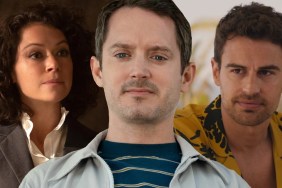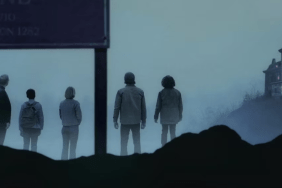
Rose Red (2002; Dir. Craig R. Baxley, W. Stephen King)
Network ABC, aired in three parts
Shirley Jacksons The Haunting of Hill House may be the most terrifying and referenced horror novel of all time. Already made into a successful film by Robert Wise in 1963, Stephen King began work on a remake with Steven Spielberg in the early 1990s. The film never went into production, as Spielberg wanted more action and King wanted to focus on the horror aspects of the film. The two agreed to shelve the project and in the late 1990s, King bought his script back and began working on it as a miniseries. Now titled Rose Red, the miniseries saw Dr. Joyce Reardon, a professor of psychic phenomenon, take a group of subjects into a reputedly haunted house. The group is chosen due to their supposed psychic abilities, in hopes of getting a reaction out of the house. While King imbued the story with elements from other supposedly real haunted houses, The Haunting of Hill House is the specter that looms largest over Rose Red.
With a massive budget, Rose Red was a big risk for a miniseries. ABC hired writer Ridley Pearson to pen a tie-in novelsupposedly written by the main character Joyce Reardonentitled The Diary of Ellen Rimbauer: My Life at Rose Red. Basing its marketing of the surprise hit The Blair Witch Project (1999), Rose Red purported to be based on real events. The book became a bestseller and was eventually turned into its own TV movie, while Rose Red was a sweeps week coup over the three nights it aired continuing the bankability of the Stephen King miniseries.

Salems Lot (remake, 2004; Dir. Mikael Salomon, W. Peter Filardi)
Network TNT, aired in two parts
The Stephen King miniseries moved away from its stronghold with ABC to embrace a moodier, darker take on the one that started it all, Salems Lot. Starring Rob Lowe (who appeared in the miniseries version of The Stand) as Ben Mears, a writer returning to his hometown only to discover that it is being overtaken by vampires, Salems Lot 2004 updates the events of the book to present day and features one of the strongest casts of any King miniseries adaptation. Alongside Lowe, the miniseries featured Donald Sutherland, Samantha Mathis, James Cromwell and Rutger Hauer as Kurt Barlow, the central vampire who takes on the more Dracula-esque persona that King ascribed to him in his original novel.
Adapted by Flatliners screenwriter Peter Filardi and directed by Mikael Salomon, who worked on TVs Alias and Band of Brothers, the remake boasts a more epic feel, with Salomon embracing the damp darkness of Kings Maine. The influence of Joss Whedons Buffy the Vampire Slayer can also be felt; the main characters are a bit sexier, brooding and investing in hair products. The miniseries still attracted a strong viewership, especially for a speciality channel, with 5.9 million tuning into first part and 5.3 tuning into the second part.

Bag of Bones (2011; Dir. Mick Garris, W. Stephen King, Matt Venne)
Network A&E, aired in two parts
Star power returned to Kings miniseries with Pierce Brosnan in an adaptation of Kings 1998 novel, Bag of Bones. Brosnan plays Mike Noonan a, writer who retreats to his cabin to process his feelings after his wife dies suddenly. While at the vacation home, hes visited by ghostly presences and wrapped up in a custody battle. Mick Garris directed the adaptation, following his work on The Stand (1994) and The Shining (1997), and still struggles with a common problem in the King miniseries. King crafts much of the plot of his stories in his characters heads, which few directorsespecially in the miniseries formathave figured out how to transfer to the screen.
Bag of Bones was met with middling reviews, praising Brosnan but criticizing the overreaching plot which became increasingly untenable and ridiculous even for a ghost story. Despite Garris influence, the tone of the piece felt uneven and often became unintentionally comical rather than eerie. Part One premiered with 3.37 million, with Part Two dropping to 2.99 million. A&E as a network tends to skew to an older demographic in terms of viewership,p so finding and maintaining a new audience in between Law & Order repeats was always going to be a challenge.
For many fans of Kings works, these miniseries have functioned as fully realized adaptations that explore the minutiae of his world. They were able to bring in new fans by airing in primetime on a major network and explore Kings stories in a longer format, rather than in the constraints of a feature film. The miniseries succeeded most when they adapted larger stories that featured communities and ensembles being visited by horror, which ultimately required and utilized the three or more hour runtimes. Overall the Stephen King miniseries effectively introduced a whole new audience to horror through the safety of their TVs and became a major part of ABCs programming for a decade, a decade where one of the masters of horror was able to build a vision of his works and make them a part of mainstream must-see-TV culture.
—
** Miniseries status has been determined by the Official Stephen King website**
Alexandra West is a freelance horror journalist who lives, works, and survives in Toronto. Her work has appeared in the Toronto Star, Rue Morgue, Post City Magazine and Offscreen Film Journal. In December 2012, West co-founded the Faculty of Horror podcast with fellow writer Andrea Subissati, which explores the analytical side of horror films and the darkest recesses of academia.









